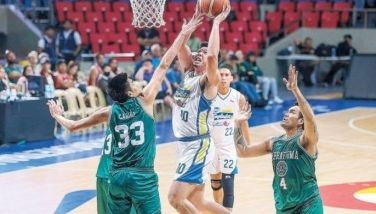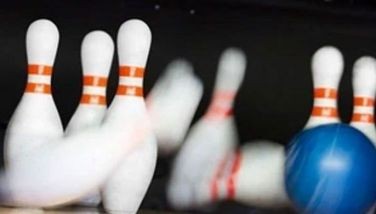The death watch on the Holy Father
April 3, 2005 | 12:00am
Yesterday, all the world seemed to have stayed glued to their television sets, or switching on and off from time to time – checking on the "death watch" on the Holy Father, Karol Wojtyla, known by the 1.1 billion Roman Catholics around this planet as Pope John Paul II.
There was no longer any doubt the Pope was dying. The only question that remained, was when.
Already it was being announced that at a conclave held by the 117 Cardinals, his successor would be chosen within 15 to 20 days after his death.
The 264th successor to the Chair of St. Peter, the Vicar of Christ, who had erupted on the world’s stage as an athletic, Broadway-charming Pontiff in 1978 – the first non-Italian Pope in 455 years, a Polish prelate from a then Communist country – ended his reign so weak, and so pitifully frail that when he tried to give his urbi et orbi Easter blessing, no words could issue from his throat, try mightily as he did.
In silence then, did the most outspoken Supreme Pontiff in history, slide towards the conclusion of his colorful, morally super-steadfast Papacy.
There are already millions of words being written or uttered about him, but perhaps I can turn back the clock to give you a glimpse of what Pope John Paul II used to be at the high noon of his Papacy. This is what I wrote in January 1983, at the time the Holy Father had declared 1983 a "Holy Year" commemorating the 1,950th anniversary of our Redemption by Jesus Christ.
In December 1982, a few days after he had made the announcement, this writer got an invitation to a "special audience" with the Holy Father in the "Sala Nervi", that impressive astrodome completed by a famous Italian architect a year or two before the present occupant of the Chair of Peter became Pope in October 1978.
Now, I’ve had special audiences with Popes before – with the marvelously human John XXIII (who broke out in hiccups five or six times) in the Sistine Chapel and with Paul VI at his summer residence at Castelgandolfo in September 1970. Pope Paul was in a hurry to get rid of us since there were other people waiting, so he gave my wife a rosary and gave me a rosary and blessed us. Then I mentioned that I had three children who were also praying for him. So he motioned to his secretary, an Irish priest with twinkling eyes, got three holy medals for him, and blessed our three children in absentia. I said that the Filipino people were praying for him also, and he got three stampitas from his assistant, and said I should give them to my children too. Then he blessed the Filipino people. I made as if to open my mouth to say something else, but catching the apprehensive look in his eye, I simply bent over to kiss his ring. He fervently blessed us both again, obviously grateful for our imminent departure.
A "special audience" with John Paul II, that Polish superstar originally known as Karol Wojtyla, is something else. It is orchestrated like a Broadway show – with lights, camera, action. Special audiences are given every Wednesday to a cast of hundreds, including scores of giggling and twittering nuns who jump up and down in excitement like teenager groupies at the prospect of shaking hands with the Holy Father or being favored with his smile. One must be careful not to be trampled by those enthusiastic Sisters who go into a paroxysms of delight at the appearance of this Pontiff who exudes charm and charisma.
Exactly at the stroke of 11 a.m., he strides into the vast hall to the joyous and resounding peal of an organ. The crowd of laymen and women, priests and nuns from three continents simply goes wild. People jostle each other for a glimpse of Pope John Paul. They put out their hands to him. His progress from entrance door to his throne on the high dais beneath a fantastic Nervi sculptural frieze of the Resurrected Christ floating amidst clouds of glory is a triumph. He shakes hands like a politician at the hustings, pressing the flesh, kissing babies, his fingers constantly being grabbed at by the Faithful (there’s no other word to describe them) who smother his ring with loyal kisses in transports of happiness little short of levitation.
Halfway down the aisle – a slow pilgrim’s progress since he stops at every group of persons to bless bowed heads and shake hands – the Pope breaks up the audience by clowning. He calls for a chair from his aides, steps up on it, and waves at everybody. When the crowd applauds, he motions like a conductor to synchronize the handclaps. He looks tired (the would-be assassin’s bullets in St. Peter’s square have taken their toll on him) but he also looks like he is enjoying himself. No Pope in the past has ever understood or harnessed the power of "personal contact" with the Church Militant as effectively as this Pontiff.
On the left side of the auditorium is the usual delegation from his native Poland, composed of blonde girls charmingly attired in their native costume with flowers around each fair brow, men in sombre dark suits and women holding up children. The group is waving a banner that reads, in Polish: "We’re from Krakow". Krakow is where the Holy Father studied for the priesthood, even while the occupying Nazis had a dragnet out for him and his colleagues. As he nears them, the Poles break into their National Anthem and then the hymn "May You Live a Hundred Years." Most of them raise their fingers defiantly in the "Solidarity" sign. Tears of pride and sorrow shine on each Polish face. Even the Romans – who at times show irritation at this constant Polish "invasion" and the weekly attempt of visiting Poles to "preempt" their Pope – are touched. They sheepishly and furtively wipe a tear or two from the corner of an eye.
When the Holy Father reaches his "throne", with a gaggle of Cardinals in complexions ranging from pink to mahogany resplendent in two rows at one side, he begins to speak Italian. There is no question as he shifts from Latin to French to German and to English that he is the Pontiff of the whole Catholic Church – 770 million strong around the globe. He does not attempt to say anything in Pilipino, Chinese or Japanese – except at New Year’s when he gives his blessing from the Vatican which is broadcast by satellite all over the world.
He talks of 1983 being a "Holy Year" and calls for prayers (not swords) around the Cross. The Soviet Union’s Joseph Stalin, during World War II, once cynically asked of the Pope: "How many Divisions has he?" Karol Wojtyla shows himself a man and leader capable of rallying many Divisions.
The paragraphs above were published, if I may repeat, in January 1983. And that’s how I hope and pray we will always remember Papa Wojtyla, the first Shepherd who jetted to his flock, not once or twice but more than a 100 times, instead of locking himself up in the Vatican as almost all of his predecessors had done.
The only other Pope who had gone out was the late Pope Paul VI, who caused a global furor in October 1965 by flying to New York on a 24-hour visit to the United Nations and to then US President Lyndon B. Johnson. This had made Pope Paul VI the first Pope to set foot outside Italy since the French ruler, Napoleon Bonaparte, had dragged Pius VII off to Paris in 1812, not to crown him (Nap seized the Crown and placed it on his own head) but to merely, perforce sanctify his Imperial Reign with a blessing.
Pope Paul VI did make another trip, one to the Philippines (November 27-29, 1970). The Holy Father had wished to honor our country as the only Catholic country in Asia.
His visit, indeed, was memorable but in a manner never intended. No sooner had the Pope descended the ramp of his aircraft at the Manila International Airport and begun the ritual of the kissing of the ring and the shaking of hands than one demented Bolivian painter named Benjamin Mendoza broke through the crowd and hurled himself at the Holy Father, brandishing a knife and shouting: "Death to superstition!" Somebody’s timely karate chop saved the Supreme Pontiff from harm and the Filipino nation from both tearful mourning and infinite embarrassment. However, screaming headlines all over the globe trumpeted the enormity of the shocking event and, in the resulting confusion and excitement, the world’s readers somehow overlooked the fact that the assailant had been a Bolivian and not a Pinoy.
All ended happily – by gosh, even for that crackpot Mendoza. He was slapped in jail but, ironically, his bizarre paintings, which had never been saleable, suddenly became a hot item in various art dealers’ shops in New York and Manila.
When Pope John Paul II himself visited Manila, he was joyously greeted by three million people!
Now, he is going… going. By the time these words appear, who knows, he may even be gone. However, he will never be forgotten.
I disagreed – but who am I? – with many dicta laid down by Papa Wojtyla. He had a warm smile, a workman’s hands, but a heart of bedrock conservatism. Yet, he stood fast by his spiritual moorings. In a world of increasing compromises, he refused to compromise.
Jesus had said to Simon-Peter in parting that he (Peter) was going to be The Rock. And on this Rock, Our Lord had vowed, "I will build my Church, and the gates of hell shall not prevail against it."
Go with God, then, Holy Father. You, too, were The Rock. And the materialistic, vain, and cynical world, or sinners like myself, did not prevail.
There was no longer any doubt the Pope was dying. The only question that remained, was when.
Already it was being announced that at a conclave held by the 117 Cardinals, his successor would be chosen within 15 to 20 days after his death.
The 264th successor to the Chair of St. Peter, the Vicar of Christ, who had erupted on the world’s stage as an athletic, Broadway-charming Pontiff in 1978 – the first non-Italian Pope in 455 years, a Polish prelate from a then Communist country – ended his reign so weak, and so pitifully frail that when he tried to give his urbi et orbi Easter blessing, no words could issue from his throat, try mightily as he did.
In silence then, did the most outspoken Supreme Pontiff in history, slide towards the conclusion of his colorful, morally super-steadfast Papacy.
There are already millions of words being written or uttered about him, but perhaps I can turn back the clock to give you a glimpse of what Pope John Paul II used to be at the high noon of his Papacy. This is what I wrote in January 1983, at the time the Holy Father had declared 1983 a "Holy Year" commemorating the 1,950th anniversary of our Redemption by Jesus Christ.
In December 1982, a few days after he had made the announcement, this writer got an invitation to a "special audience" with the Holy Father in the "Sala Nervi", that impressive astrodome completed by a famous Italian architect a year or two before the present occupant of the Chair of Peter became Pope in October 1978.
Now, I’ve had special audiences with Popes before – with the marvelously human John XXIII (who broke out in hiccups five or six times) in the Sistine Chapel and with Paul VI at his summer residence at Castelgandolfo in September 1970. Pope Paul was in a hurry to get rid of us since there were other people waiting, so he gave my wife a rosary and gave me a rosary and blessed us. Then I mentioned that I had three children who were also praying for him. So he motioned to his secretary, an Irish priest with twinkling eyes, got three holy medals for him, and blessed our three children in absentia. I said that the Filipino people were praying for him also, and he got three stampitas from his assistant, and said I should give them to my children too. Then he blessed the Filipino people. I made as if to open my mouth to say something else, but catching the apprehensive look in his eye, I simply bent over to kiss his ring. He fervently blessed us both again, obviously grateful for our imminent departure.
A "special audience" with John Paul II, that Polish superstar originally known as Karol Wojtyla, is something else. It is orchestrated like a Broadway show – with lights, camera, action. Special audiences are given every Wednesday to a cast of hundreds, including scores of giggling and twittering nuns who jump up and down in excitement like teenager groupies at the prospect of shaking hands with the Holy Father or being favored with his smile. One must be careful not to be trampled by those enthusiastic Sisters who go into a paroxysms of delight at the appearance of this Pontiff who exudes charm and charisma.
Exactly at the stroke of 11 a.m., he strides into the vast hall to the joyous and resounding peal of an organ. The crowd of laymen and women, priests and nuns from three continents simply goes wild. People jostle each other for a glimpse of Pope John Paul. They put out their hands to him. His progress from entrance door to his throne on the high dais beneath a fantastic Nervi sculptural frieze of the Resurrected Christ floating amidst clouds of glory is a triumph. He shakes hands like a politician at the hustings, pressing the flesh, kissing babies, his fingers constantly being grabbed at by the Faithful (there’s no other word to describe them) who smother his ring with loyal kisses in transports of happiness little short of levitation.
Halfway down the aisle – a slow pilgrim’s progress since he stops at every group of persons to bless bowed heads and shake hands – the Pope breaks up the audience by clowning. He calls for a chair from his aides, steps up on it, and waves at everybody. When the crowd applauds, he motions like a conductor to synchronize the handclaps. He looks tired (the would-be assassin’s bullets in St. Peter’s square have taken their toll on him) but he also looks like he is enjoying himself. No Pope in the past has ever understood or harnessed the power of "personal contact" with the Church Militant as effectively as this Pontiff.
On the left side of the auditorium is the usual delegation from his native Poland, composed of blonde girls charmingly attired in their native costume with flowers around each fair brow, men in sombre dark suits and women holding up children. The group is waving a banner that reads, in Polish: "We’re from Krakow". Krakow is where the Holy Father studied for the priesthood, even while the occupying Nazis had a dragnet out for him and his colleagues. As he nears them, the Poles break into their National Anthem and then the hymn "May You Live a Hundred Years." Most of them raise their fingers defiantly in the "Solidarity" sign. Tears of pride and sorrow shine on each Polish face. Even the Romans – who at times show irritation at this constant Polish "invasion" and the weekly attempt of visiting Poles to "preempt" their Pope – are touched. They sheepishly and furtively wipe a tear or two from the corner of an eye.
When the Holy Father reaches his "throne", with a gaggle of Cardinals in complexions ranging from pink to mahogany resplendent in two rows at one side, he begins to speak Italian. There is no question as he shifts from Latin to French to German and to English that he is the Pontiff of the whole Catholic Church – 770 million strong around the globe. He does not attempt to say anything in Pilipino, Chinese or Japanese – except at New Year’s when he gives his blessing from the Vatican which is broadcast by satellite all over the world.
He talks of 1983 being a "Holy Year" and calls for prayers (not swords) around the Cross. The Soviet Union’s Joseph Stalin, during World War II, once cynically asked of the Pope: "How many Divisions has he?" Karol Wojtyla shows himself a man and leader capable of rallying many Divisions.
The paragraphs above were published, if I may repeat, in January 1983. And that’s how I hope and pray we will always remember Papa Wojtyla, the first Shepherd who jetted to his flock, not once or twice but more than a 100 times, instead of locking himself up in the Vatican as almost all of his predecessors had done.
The only other Pope who had gone out was the late Pope Paul VI, who caused a global furor in October 1965 by flying to New York on a 24-hour visit to the United Nations and to then US President Lyndon B. Johnson. This had made Pope Paul VI the first Pope to set foot outside Italy since the French ruler, Napoleon Bonaparte, had dragged Pius VII off to Paris in 1812, not to crown him (Nap seized the Crown and placed it on his own head) but to merely, perforce sanctify his Imperial Reign with a blessing.
Pope Paul VI did make another trip, one to the Philippines (November 27-29, 1970). The Holy Father had wished to honor our country as the only Catholic country in Asia.
His visit, indeed, was memorable but in a manner never intended. No sooner had the Pope descended the ramp of his aircraft at the Manila International Airport and begun the ritual of the kissing of the ring and the shaking of hands than one demented Bolivian painter named Benjamin Mendoza broke through the crowd and hurled himself at the Holy Father, brandishing a knife and shouting: "Death to superstition!" Somebody’s timely karate chop saved the Supreme Pontiff from harm and the Filipino nation from both tearful mourning and infinite embarrassment. However, screaming headlines all over the globe trumpeted the enormity of the shocking event and, in the resulting confusion and excitement, the world’s readers somehow overlooked the fact that the assailant had been a Bolivian and not a Pinoy.
All ended happily – by gosh, even for that crackpot Mendoza. He was slapped in jail but, ironically, his bizarre paintings, which had never been saleable, suddenly became a hot item in various art dealers’ shops in New York and Manila.
When Pope John Paul II himself visited Manila, he was joyously greeted by three million people!
Now, he is going… going. By the time these words appear, who knows, he may even be gone. However, he will never be forgotten.
I disagreed – but who am I? – with many dicta laid down by Papa Wojtyla. He had a warm smile, a workman’s hands, but a heart of bedrock conservatism. Yet, he stood fast by his spiritual moorings. In a world of increasing compromises, he refused to compromise.
Jesus had said to Simon-Peter in parting that he (Peter) was going to be The Rock. And on this Rock, Our Lord had vowed, "I will build my Church, and the gates of hell shall not prevail against it."
Go with God, then, Holy Father. You, too, were The Rock. And the materialistic, vain, and cynical world, or sinners like myself, did not prevail.
BrandSpace Articles
<
>
- Latest
- Trending
Trending
Latest































